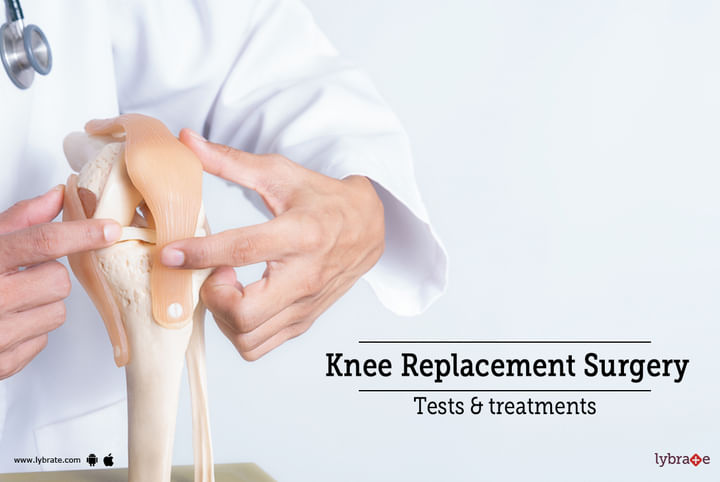Knee Replacement Surgery - Tests and treatments
Knee replacement surgery, also known as arthroplasty, is a medical procedure that entails replacing a damaged, worn, or diseased knee joint with an artificial joint. This type of surgery is frequently performed to address knee pain caused by arthritis and has become a routine operation.
Tests for Knee Replacement Surgery:
Before undergoing knee replacement surgery, there are several tests that must be conducted to ensure that you are a suitable candidate for the procedure. These tests may include:
- X-rays - X-rays are a type of electromagnetic radiation, which are energy waves that travel through space at the speed of light. As X-rays pass through the body, different tissues absorb them to varying degrees, which is determined by their density. This creates a pattern of varying shades of black and white on the resulting X-ray image, which healthcare providers can use to diagnose and monitor a wide range of medical conditions.
- MRI - MRI is a medical diagnostic tool that uses a powerful magnetic field and radio waves to create detailed images of the body's internal structures. Unlike X-rays and CT scans, MRI doesn't use ionizing radiation, which can pose a health risk. Instead, it uses harmless radio waves to produce clear and accurate images. During an MRI scan, the patient lies comfortably inside a large tube-shaped machine, which is surrounded by a powerful magnetic field. The magnetic field causes the protons in the body's tissues to align in a specific way, and when radio waves are applied, the protons emit signals that can be detected by the MRI machine. These signals are then processed by a computer to create detailed images of the body's internal structures, such as organs, bones, and soft tissues.
- Blood Tests - Blood tests are laboratory analyses of blood samples that can help healthcare providers evaluate a person's overall health, monitor the progress of a medical condition, or diagnose a new condition. Blood tests can measure various substances in the blood, such as hormones, enzymes, proteins, and electrolytes, as well as the number and type of blood cells. Blood tests are used for a wide range of purposes, from routine checkups to diagnosing and monitoring chronic conditions such as diabetes, high cholesterol, and thyroid disorders.
- Urine Tests - A urinalysis is a common diagnostic test that involves analyzing a person's urine to evaluate their overall health and detect potential medical conditions. During a urinalysis, a sample of urine is collected and analyzed for various characteristics, such as color, clarity, odor, pH, and specific gravity.
- Electrocardiogram (ECG) - Electrocardiography, often abbreviated as ECG or EKG, is a non-invasive medical test that records the electrical activity of the heart over time. This test is performed using a device called an electrocardiogram, which uses small metal electrodes attached to the skin to detect and record the electrical impulses generated by the heart. During an ECG, the electrodes are attached to specific locations on the patient's chest, arms, and legs, and the resulting electrical signals are recorded and displayed on a monitor or printed out on paper. The ECG waveform provides important information about the heart's rhythm and electrical activity, which can help diagnose a wide range of cardiac conditions, including arrhythmias, heart attacks, and heart disease.
Treatments for Knee Replacement Surgery:
When it comes to knee replacement surgery, there are various treatment options available that can be customized to cater to the specific requirements of each patient. These treatments are designed to meet the unique needs of the individual and may include non-surgical therapies, such as medication and physical therapy, or surgical interventions, such as partial or total knee replacement. The choice of treatment depends on various factors, including the extent of knee damage, the age and health of the patient, and their personal preferences.
- Partial Knee Replacement - Partial knee replacement, also called unicompartmental knee arthroplasty, is a surgical procedure that involves replacing the damaged part of the knee joint, instead of the entire joint. This type of surgery is suitable for individuals who have damage to only one part of the knee joint, usually caused by osteoarthritis. In this surgery, the surgeon will make a small incision in the knee and remove the damaged part of the joint. Then, a prosthetic component made of metal and plastic will be inserted to replace the removed part. This prosthetic component is designed to replicate the natural movement of the knee joint, and will be connected to the healthy parts of the knee joint that remain. The result is a new knee joint that can function similarly to the original joint, but without the pain and limitations caused by the damage.
- Total Knee Replacement - Total Knee Replacement (TKR), also referred to as total knee arthroplasty, is a type of surgery that aims to replace a knee joint that has been damaged or affected by a disease with an artificial joint. The procedure is typically recommended for patients who have severe knee pain and disability due to conditions such as osteoarthritis, rheumatoid arthritis, or post-traumatic arthritis. During a TKR surgery, the damaged cartilage and bone of the knee joint are removed and replaced with a prosthesis made of metal alloys, plastics, and polymers. The prosthesis is designed to mimic the function of a natural knee joint, allowing for improved mobility and a reduction in pain. After undergoing Total Knee Replacement (TKR) surgery, the recovery process often involves a combination of physical therapy and rehabilitation.
- Minimally Invasive Knee Replacement - Minimally invasive knee replacement surgery is a medical intervention designed to replace a knee joint that has suffered damage or disease with an artificial joint. The primary objective of this surgical procedure is to reduce the level of trauma to the tissues surrounding the knee joint. Unlike traditional knee replacement surgery, which requires a large incision and significant cutting of muscles and tendons, minimally invasive knee replacement involves smaller incisions and specialized instruments that allow for a more targeted approach. During the procedure, the surgeon uses a specialized technique to access the knee joint through a smaller incision, often around 3-4 inches in length. The surgeon then carefully moves aside muscles and tendons to access the joint, rather than cutting through them, which helps to minimize tissue damage and promote faster healing.
- Rehabilitation - Rehabilitation is a process that aims to restore an individual's physical, psychological, and social well-being after a disease, injury, or disability. The primary objective of rehabilitation is to assist individuals in regaining their independence, improving their quality of life, and enhancing their ability to perform daily activities. The rehabilitation process typically involves a team of healthcare professionals from various specialties working together to develop a personalized treatment plan that is tailored to the individual's specific needs and goals. This team-based approach allows for a more comprehensive and holistic approach to rehabilitation, as each professional brings their unique expertise and perspective to the table.
If you are experiencing chronic knee pain, speak to your doctor to determine whether knee replacement surgery is an appropriate treatment option for you.



+1.svg)
